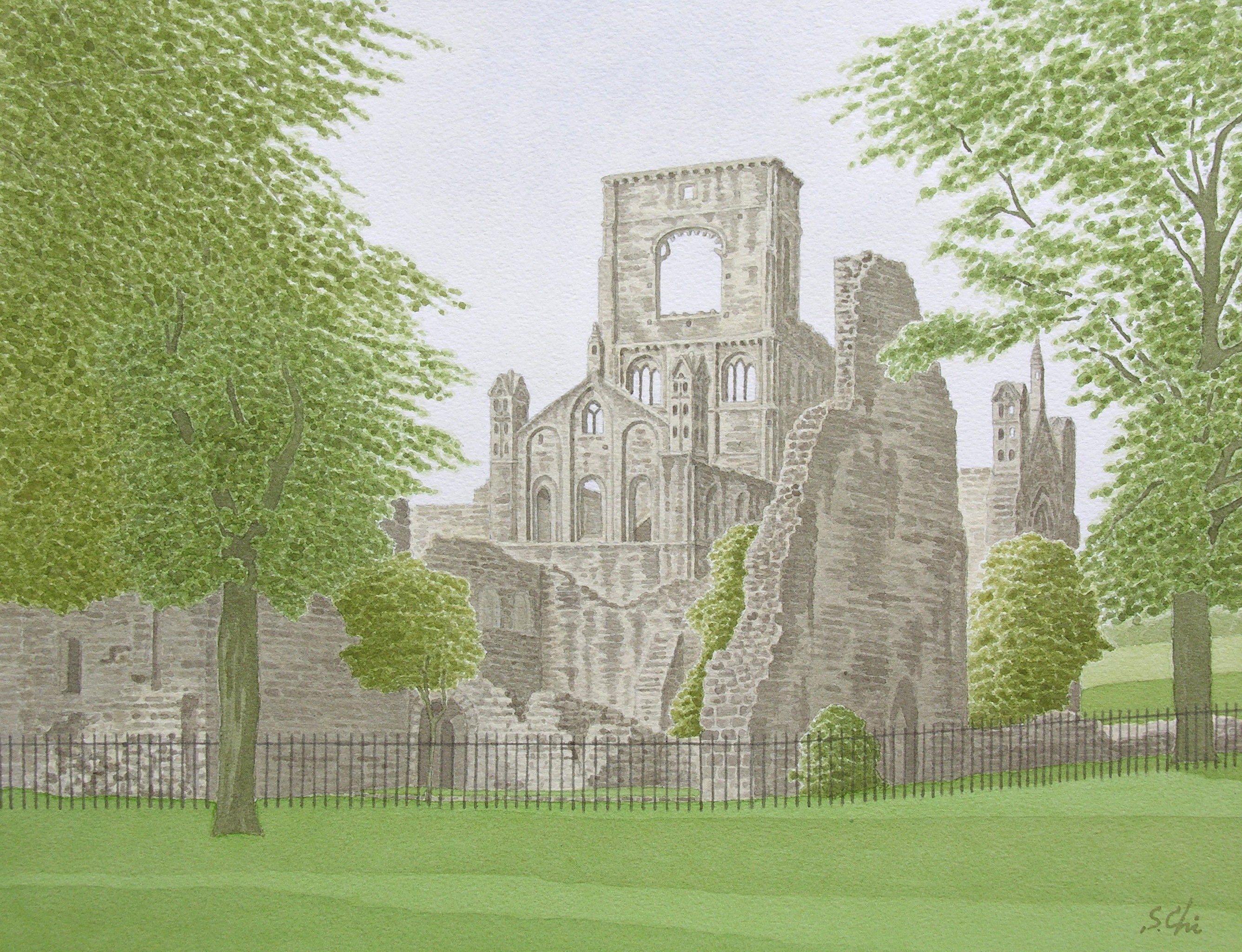
遥かなる わがヨークシャー (Faraway My Yorkshire)
リーズ (Leeds)
3 カークストール修道院 (Kirkstall Abbey)

日本で「廃墟」という言葉を見聞きすると、ただ見捨てられた廃屋や廃工場を連想しがちである。しかしイギリスでは、この「廃墟 (ruins)」という言葉には、少しちがったイメージと響きがある。
この国には中世の石造りの城や修道院の廃墟が数多くある。それらは、そのまま、ロマン派の絵画にでてくるような、廃墟ならではのロマンティックな姿をしている。屋根がすっかり落ち、外壁だけが残っているところもあれば、その外壁も崩れ落ち、わずかに基礎だけが残されているところもある。
城や修道院の廃墟は、訪れる者に歴史や過去の出来事、栄枯盛衰を静かに語りかけ、人をいにしえの世界へといざなう、独特の雰囲気をもった空間である。
リーズ市の経済発展の出発点となったカークストール修道院の廃墟は、市の中心部から北西に4・5kmほど行ったところにある。
カークストール修道院は、ヨークシャーで最大勢力を誇っていたファウンテンズ修道院の分院として、1152年に建設がはじまり、1182年に完成したとされる。15世紀の終わりころから16世紀の初めにかけて一部が改造されているが、大部分が簡素なノルマン様式で、イギリスでもその好例とされている。
この廃墟で見る者の目を最初にひくのが、廃墟の上にひときわ高く突き出た四角い壁である。聖堂*の交差部の上にあった中央塔の4面の壁のうちの一つであるが、「これでよく崩れないものだ」と思うほど、あぶなっかしく見える。廃墟ならではの、劇的な姿である。
つぎにこの廃墟で気がつくことは、全体が真っ黒に煤けていることである。
カークストール修道院は、ヘンリー8世の修道院解散によって1539年に解散させられ、その後廃墟になっていった。修道院が所有していた土地は、一時カンタベリー大主教トマス・クランマーに下賜されたことがある。しかし彼がメアリー1世(在位1553-58)の時代に旧教であるカトリックへの改宗を拒みつづけたために火刑になると、土地は没収されて王室のものとなった。その後、所有者は転々とし、最後にはカーディガン伯爵領に組み入れられていった。
1740年代に、イギリスで廃墟ブームが起こった。このとき、都市の近郊にあったカークストール修道院は、多くの市民や詩人・画家などが訪れる行楽地になった。
画家のJ. M. W. ターナー(1175-1851)は、イングランド北部を何度も旅行し、数多くのスケッチや水彩画を残している。1798年には、カークストール修道院の廃墟を水彩画に描いている。エア川越しに、陽光をうけて白くかがやく廃墟を描いた絵である。ターナーがまだ若いころの、自然主義的な描き方をしていた時代のものである。
また水彩画家のトマス・ガ―ティン(1775-1802)も、1802年に廃墟を東の遠方から見て描いた絵『カークストール修道院』を残している。この絵は、彼の代表作の一つであると同時に、イギリスの水彩画の傑作の一つでもある。
1889年、この廃墟を軍人のジョン・ノース大佐が買いとり、これをリーズ市に寄贈した。そしていまは、市によって史跡として保存・管理されている。
この廃墟が真っ黒に煤けているのは、工場からの煙に身をさらしながら、産業革命以来のリーズ市の発展を、間近に見てきた証だろうか。
The word "ruins" reminded me of broken houses or factories when I was in Japan. But in England the images of the word were quite different from those of Japan. I found the ruins of medieval castles and abbeys of England were very beautiful, tranquil and romantic places to remind me of many historic events, and I was fascinated by the ruins very much.
The ruins of Kirkstall Abbey lie about 3 miles to the northwest of Leeds
city centre. It was founded in 1152 by the Cistercians as a daughter house
of Fountains Abbey, and was completed in 1182. Then it was dissolved in
1539 and became ruined. The abbey was granted to Thomas Cranmer, Archbishop
of Canterbury in 1542, but in 1556, reverted to the Crown when he was burnt
to death by Mary I for his religious beliefs of Protestant.
Kirkstall Abbey is said to be the finest early Cistercian house in austere
Norman style in England.
When I saw it, I was impressed by the soaring wall of a broken central
tower at first. It is a really dramatic and fantastic scene which only
ruins have. The abbey, originally constructed with yellowish grey sand
stone, blackened over the years. The ruins suffered from the growth of
Leeds as an industrial city long after the Dissolutions of the Monasteries,
being exposed to the smoke from the factories.
When the boom of ruins occured in the 1740s, as it was situated in the
suburbs of Leeds, Kirkstall Abbey became a very popular picnic site for
the citizens. Many poets and writers visited there and artists such as
J. M. W. Tuner and Thomas Girtin painted the ruins in watercolours.
I love Girtin's work entitled "Kirkstalkl Abbey"which was painted
in 1802 from the eastern faraway place. The ruins which he painted were
shinning white, reflecting the sunlight in the grandeur view of Airedale.
It is the most famous picture by him and really one of the masterpieces
of watercolours.
I read that the economic activities of Kirkstall abbey, which were inherited
by the ambitious new middle class after the Dissolutions of the Monasteries,
had become the foundations of Leeds as an industrial city.
*聖堂(church) 上から見ると十字架の形をしており、頭部を東に向けて建てられている。頭部にあたる東側を身廊内陣といい、そこには東端に祭壇があり、聖職者と聖歌隊の席がある。西側は身廊外陣といい、一般信者席になっている。また身廊の壁側は側廊と呼ばれる。腕にあたる南北方向には翼廊がある。身廊と翼廊との交差部の上には、明りを取るための中央塔がある。